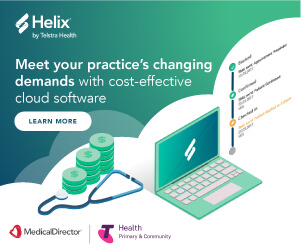7 Digital healthcare predictions for 2020
Digiceuticals, predictive analytics, AI, cloud and virtual reality – the future of our technology-enabled health system is changing fast. In fact, the global digital health market is expected to reach a valuation of more than $234 billion by 2023, up from 2019’s estimated $147 billion, according to a new Frost & Sullivan report. The report sees this rising trend as driven by the healthcare industry’s ongoing transition toward a model of value-based care.
Let’s take a look at what 2020 holds for technological innovations shaping the future of health
1. AI and predictive analytics
Healthcare is set to undergo a significant data revolution, as artificial intelligence (AI), predictive analytics and business intelligence are set to drive efficiency and optimise better health outcomes. The World Economic Forum predicts that AI will be widely used to reveal currently unknown patterns in disease, treatment and care by 2030.
Meanwhile, the recent Frost & Sullivan Global Healthcare Market Outlook, reveals data analytics is set to grow to a footprint encompassing at least 65 percent of the world’s data health market.
Already, AI and deep learning is being used in healthcare is image classification, which enables extracting information from multiple images to help healthcare providers like radiologists mark file and mark low priority X-rays, making the process quicker, easier and more accurate.
Meanwhile in the UK, researchers at Oxford Hospital are using this technology to help improve diagnosis for heart disease and lung cancer. AI can also help primary doctors fund and refer patients to specialists faster, and offer more fast, accurate and actionable insights for doctors and their patients.
In China, a recent study revealed a new artificial intelligence system designed to diagnose childhood diseases, could even recognise symptoms more accurately than many human doctors. The “deep learning” programme, tested in China, assimilated information from more than 1.4 million electronic health records.
It was then able to draw on its “experience” to diagnose a broad range of childhood diseases, with accuracy rates of more than 90% in some cases. But although the system performed better than junior doctors, it did not perform as well as more senior experienced physicians
2. The convergence of AI, Blockchain and IoT
In 2020, the convergence of Artificial Intelligence (AI), Blockchain, and the Internet of Things (IoT) are set to further boost innovation in healthcare, the Frost & Sullivan Global Healthcare Market Outlook predicts. According to that report, while blockchain will improve data liquidity to empower AI and analytics vendors/applications to digest a large amount of data, AI can manage blockchain systems more efficiently than humans.
Already, the Garvan Institute announced it is investigating whether blockchain technology can be used to help citizens get more control over their health data. Meanwhile in the US, blockchain echnology is already being utilised for medical records by establishing a secure distributed medical records system in an effort to tighten security and privacy.
But while disruptive technologies, AI and machine learning can be powerful tools to drive better health outcomes for the year ahead, MedicalDirector’s CEO, Matthew Bardsley warns that in a fear-based economy, the AI-enabled predictions need to be fully understood within the context of each individual person and their circumstances.
“For AI to really be a powerful tool in healthcare and enabler of better health outcomes, we need to make sure it is done respectfully, there is a level of empathy in the system, and a layer of emotional artificial intelligence, before it can be unleashed into the healthcare ecosystem,” he explained. “Otherwise just one health prediction delivered incorrectly can lead to a life or death situation for a patient, and stifle innovation.”
“Moving forward, innovators in healthcare need to understand and respect this layer of emotional AI required, and really lean into this problem and understand its repercussions, so healthcare can enjoy the same capabilities as other parts of the market.”
3. Internet of medical things (IoMT) and ‘Digiceuticals’
The age of ‘digiceuticals’ is well and truly here, with the Frost & Sullivan report revealing digital therapeutics will direct the development of information and communications technology. Meanwhile remote patient monitoring is set to expand beyond chronic disease management, as digital health opportunities continue to increase, the report predicts.
But unlike mainstream digital wellness devices and apps, digiceuticals have been tested for efficacy, approved by regulatory agencies such as the FDA and are prescribed by medical practitioners.
Most digiceuticals gather specific health data, either by asking patients for information or by using sensors, and provide real-time guidance. For instance, diabetes apps can work with connected monitors and use the information to manage symptoms.
“I really can see the benefits of ‘prescribing’ these therapeutic apps to our patients,” MedicalDirector’s Chief Medical Officer and GP Dr Charlotte Middleton said. “It’s these sort of patient-centric innovations that will help to improve patient engagement and health outcomes moving forward.”
According to MedicalDirector’s CEO Matthew Bardsley, as a result of this increased digiceutical trend, individual users now have a wealth of data on their own wellbeing at their fingertips, making them far more empowered and equipped to track and monitor their own health and to some extent, even self-diagnose.
“Technology is now not only giving people incentive to become more deeply involved and interested in their own health, but they can easily share these data sets with their health practitioners in a far more accurate and structured way,” he said. “This means for the first time, the information asymmetry is changing where digitally agile patients will now have far more personal health tracking data on their own devices than their practitioner has on file. And it’s nothing to be afraid of. In fact, there are many mid-term and long-term benefits.”
4. Virtual care, telehealth and patient-centric care
Telehealth, currently segmented, will be optimised into an end-to-end solution, accelerating digital health convergence, the Frost & Sullivan report predicts. This is in line with Forrester’s study last year, Predictions 2019: Healthcare, CX Measurement Frameworks, Virtual Care, And AI Come To The Fore, which predicted virtual care to be crucial to patient acquisition and retention.
In 2019, a new report commissioned by Philips, Telehealth: delivering value across institutional and geographical borders, further revealed while there is an appetite for telehealth in the industry, there are some barriers to adoption, including implementation and integration time and costs.
Virtual care, otherwise known as telehealth, is the delivery of health-related services and information via technology outside the physical ‘walls of the consulting room’, and is increasingly becoming a critical enabler of more personalised, patient-centric care.
“There are so many ways now to practice medicine ‘outside of the consulting room’, which is particularly useful for to support rural and mental health patients, who are either physically or psychologically unable to reach a face-to-face consultation,” Dr Middleton said. “Plus technological innovations are popping up every day to complement virtual care in Australia.
“For instance, there are technologies that can match patients with clinical trials or to psychologists. Technology is becoming more accepted as an effective way health professionals can connect with patients to enable better health outcomes.”
5. Healthcare in the cloud
Innovative cloud practice management solutions are already gaining momentum over server-based practice management, as they support increased collaboration in healthcare. But according to a new report from Corinium Intelligence, In 2020, cloud-based electronic health records (EHR) are set to integrate with AI and machine learning in far more sophisticated ways, opening up a new and exciting age of interoperability.
This is because cloud platforms will enable more empowered use of data, with technology enabling practitioners to better collect, manage, analyse and share relevant data within the healthcare ecosystem.
“A key benefit of cloud health software is that it supports better real-time communication,” Dr Middleton said. “For instance, it supports digital referrals, faster communication between primary healthcare providers and hospitals, as well as better communication between GPs and allied health providers. Ultimately, it is this real-time benefit of cloud software that helps support interoperability in the wider health ecosystem.”
But achieving interoperability requires healthcare providers and vendor companies to cooperate and use shared data standards, the Corinium Intelligence report stressed. Importantly, the report highlighted the proliferation of interoperability means healthcare as a whole will need a heightened level of data literacy in order to effectively optimise patient outcomes.
“There’s still a great deal of work to be done before Electronic Health Records (EHRs) can achieve their full potential,” the report states.
6.VR, medical training and mental health
Virtual reality is set to change the lives of patients and physicians alike in the year ahead. Already, Embodied Labs’ “We Are Alfred” uses VR technology to show young medical students what ageing means. Everyone can be the hypothetical ‘Alfred’ for 7 minutes, and experience how it feels like to live as a 74 year-old man with audio-visual impairments. The technology’ goal is to solve the disconnection between young doctors and elderly patients due to their huge age difference.
Meanwhile giving birth has also been propelled into the virtual space with new innovations in both virtual reality and augmented reality developed by the University of Newcastle (UON). Using the Samsung GearVR and HTC Vive (VR) and HoloLens (AR) headsets, UON students will be among the first in the world to learn key anatomy changes, birthing techniques and real-world emergency scenarios via virtual and augmented simulation
“The real potential I see with virtual reality is how it can facilitate education and learning in General Practice” Dr Middleton said. “There are some great innovations in this area, that are set to be rolled out and developed even further as fantastic health education tools.
In 2020, The University of Wollongong sees VR as not only having an impact on treating patient’s physical health, but being able to have a profound impact on mental health patients, particularly those in remote or rural locations.
Shiva Pedram, Associate Research Fellow at the University of Wollongong, conducted extensive research on finding better ways to improve remotely delivered mental health care. The research found using VR for remote therapy, which involves conducting “face-to-face” sessions in a virtual environment, could make counselling more accessible to those living and working remotely.
“Personally, I think it will also open up exciting new opportunities to better facilitate patient engagement, and offer a more personalised approach to the patient experience,” Dr Middelton added. “It’s an innovative way for patients to understand more about their condition, treatment or what to expect in their upcoming procedure.”
7. Genomic testing and precision medicine
Genomics is becoming increasingly more pervasive in the future of healthcare, as more government bodies and healthcare organisations start preparing for a new era of precision medicine. For 2020, experts agree genomic testing for clinical diagnosis is already becoming a routine part of medical care. Over the next few years the results will be used to inform personalised treatment more often, especially in rare diseases, or cancer patients, with improved outcomes and fewer side effects
Last year, report released from the Australian Council of Learned Academies (ACLA), The Future of Precision Medicine, predicted Australians will be able to have their genomes mapped within the next 25 years, and health systems will be required to offer this high tech test, as healthcare moves more towards a focus on preventing diseases.
Precision medicine, the report said, encompasses a broad remit, including genomics and other ‘omics’ (metabolomics, microbiomics, proteomics and transcriptomics), epigenetics, gene editing technologies such as CRISPR and the development of targeted therapies specific to an individual’s disease profile.
And advances in genome sequencing and the associated field of genomics are set to offer us better understanding of how diseases affect different individuals. With the genetic profile of a person’s disease, and knowledge of their response to treatment, it should be possible to find out more about the likely effectiveness of medical interventions such as prescribing drugs to treat a disease (pharmacogenomics).
“I definitely see genomics, precision medicine, and personalised medicine as being part of the future of medicine,” Dr Middleton said. “But at the same time, we have to ensure there are evidence-based systems in place to ensure we obtain true results we can trust and act upon.“The information we obtain is astronomical and can have a profound impact on a patient’s health and psyche – in terms of what you may be revealing to them that they’re predisposed to. So we need to give our approach to genomics a lot of thought and develop some fail-safe protocols behind using it.”









